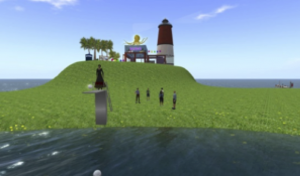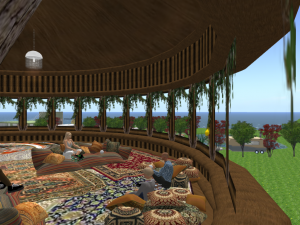About EVA
EVA Park is a multi-user online virtual world that gives people with aphasia unique opportunities to practise their speech and establish social connections. It contains various virtual locations including shops, restaurants, a hairdressers, houses, a bar and disco. Users are represented by personalised avatars and communicate by talking to each other.
EVA Park was created by the EVA project at City, University of London via a process of co-design involving usability experts, speech and language therapy researchers and consultants with aphasia. A study involving 20 people with aphasia showed that using EVA Park led to an improvement in functional communication.
Funding
1. The EVA Project. Sep 2012 – Sep 2015
Funded by the Stroke Association, this project developed and tested EVA Park.
2. EVA Impact Project. Oct 2015 – May 2016
Funded by City University London, this project ran open days and developed impact from the research.
3. EVA Park Technical Development. May 2016 – May 2017
Funded by The Tavistock Trust for Aphasia, this project delivered an updated, service-ready version of EVA Park.
4. EVA Park Case Studies. May 2016 – May 2017
Funded by The Tavistock Trust for Aphasia, this project ran a series of case studies to investigate alternative ways of delivering speech and language therapy in EVA Park.
5. EVA Park Groups. Jan 2017 – Oct 2018
Funded by the Stroke Association, this project investigated how EVA Park can support social connectedness and well-being for people with aphasia.
Research
EVA Park was originally developed by the EVA research project (2012 – 2015) at City University of London, with funding from the Stroke Association. There were 4 main research objectives:
1. To develop a multi-user virtual world for people with aphasia.
2. To investigate the accessibility and usability of the virtual world for people with aphasia.
3. To assess the impact of practising speech in the virtual world on communication skills.
4. To assess the impact of the virtual world on feelings of social isolation.
Outcomes
1. EVA Park, a multi-user virtual world
EVA Park is a multi-user online virtual world. It is functional and fantastical, with virtual spaces such as a restaurant, a clinic and a tardis which provide settings for grounded conversations.
The first phase of the project developed EVA Park in collaboration with five people who have aphasia. Each of these five people participated in up to ten co-design workshops. They helped us understand the types of places that people with aphasia would both enjoy and find useful to visit in EVA Park. For example, they were keen to practice conversations in social situations such as in a bar or a nightclub. They also participated in the evaluation of EVA Park as it evolved and they evaluated different interaction devices. A variety of participatory design techniques were used, including phone diaries and photos, crowd sourcing, personas, stories, observations and interviews. These techniques were modified to make them accessible to people with impaired communication skills.
Many thanks to Justine, Steve, Pedro, Jeffrey and Sarah.
2. The impact of using EVA Park on communication skills and feelings of social isolation
A two year experimental study investigated the impact of using EVA Park on communication skills, social connectedness and feelings of social isolation. Twenty people with aphasia participated in the study. Each had 5 weeks access to EVA Park, logging in with a personalised avatar for 1 hour a day, five days a week. They were paired with a communication support worker who met them in world, set and worked towards conversation goals, and engaged in role play situations. We collected data at baseline and afterwards to measure communication skills and social isolation.
The study employed a quasi randomised design, which compared a group that received immediate intervention with a waitlist control group. Outcome measures were the Communication Activities of Daily Living test (CADL-2) (Holland et al, 1999), a fluency naming test, measures of word retrieval in conversation and narrative, The Communication Confidence Rating Scale (Babbitt and Cherney, 2010), and The Friendship Scale (Hawthorne, 2006). Structured observations of participants using EVA Park and interviews explored accessibility and acceptability.
Participants practised a range of functional conversations e.g. discussing their child’s progress with the teacher, sharing details of their career before their stroke, having a haircut. The fun elements of EVA Park provided stimuli for conversations e.g. ‘have you seen what’s inside the Tardis?’. Conversation groups took place. These were initially led by the communication support workers and later by participants themselves. Topics covered were news, music, sports and celebrity gossip.
Participants have also embraced the imaginative opportunities provided by the virtual world: they have gone ‘swimming’ in the lake and organised a ‘fun day’ consisting of races around the island and a diving competition. This allowed for a very different use of language than might otherwise be elicited in traditional speech and language therapy sessions.
The twenty participants found EVA Park to be a fun and creative place, providing exciting opportunities for practising both social and functional language in a stimulating 3D environment. There were significant gains on the CADL-2, showing that participants’ functional communication improved by the end of 5 weeks using EVA Park. Fluency naming and the Confidence Rating Scale also improved, but changes could not be attributed to intervention. Word retrieval in conversation and narrative did not change; nor did the Friendship Scale.
3. The accessibility and usability of EVA Park for people with aphasia.
Observations were conducted in weeks 2 and 5 of the experimental study to investigate the accessibility and user experience of EVA Park: a researcher visited each participant at home and observed and recorded one of the scheduled sessions in these weeks. Participants were also interviewed briefly about their experience of EVA Park in week 5. The observational data were then scored to determine which of 33 possible tasks participants were observed to carry out successfully in these sessions. Results revealed that participants were successful at critical tasks.
Awards
2016 NT100: EVA Park was recognised in the 2016 NT100 – Nominet Trust’s annual celebration of the people and organisations using digital technology to change the world for the better. Discover the #2016NT100 at http://www.socialtech.org.uk/nominet-trust-100/2016/.
Tech4Good Awards 2015: EVA Park won the People’s Award in the Tech4Good Awards 2015.
Acknowledgments: Creators of Objects and Scripts Reused in EVA Park
Linda.Kellie @hg.osgrid.org
Fleep.Tuque @fleepgrid.com
rumegusc.altamura @craft-world.org:8002
Licu.Rau @craft-world.org:8002
Tosha.Tyran @craft-world.org:8002
hylee.bekkers @hg.osgrid.org
Nebadon.Izumi @grid.osgrid.org:8002
JP via OpenSim Creations
Yanna.Laval @hg.osgrid.org
LisaKathleen.Kaligawa @hg.osgrid.org
Donarl Default
cyrus.gray @hg.osgrid.org
Anachron.Young @dorenas-world.de:8002
Sophia.Undercroft @hg.osgrid.org
Pluto.Fairey @avirtualworld.dyndns.org:8002
Boba.Solo @hg.osgrid.org
Al.Al @users.osgrid.org


